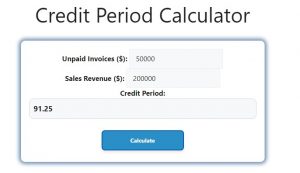About Credit Period Calculator (Formula)
In business finance, managing cash flow is crucial for maintaining a healthy operational status. One important aspect of cash flow management is understanding the credit period, which refers to the time allowed for payment of a debt. A Credit Period Calculator helps businesses determine how long their customers take to pay their invoices relative to the total sales revenue. By analyzing the credit period, companies can make informed decisions about extending credit, managing inventory, and optimizing cash flow, ensuring financial stability and growth.
Formula
The formula for calculating the credit period is:
Credit Period (CP) = 365 * (Unpaid Invoices / Sales Revenue)
Where:
- CP = Credit Period (in days)
- Unpaid Invoices = The total amount of invoices that remain unpaid.
- Sales Revenue = The total revenue generated from sales over a specific period.
How to Use
Using the Credit Period Calculator is a straightforward process:
- Gather Required Data: Collect the total amount of unpaid invoices and the total sales revenue for the desired period.
- Input Values into the Formula: Substitute the collected values into the credit period formula.
- Perform the Calculation: Calculate the credit period using the formula provided.
- Analyze the Result: Interpret the credit period to understand how long, on average, it takes for customers to pay their invoices. A shorter credit period generally indicates efficient payment practices, while a longer period may signal potential cash flow issues.
Example
To illustrate how to use the Credit Period Calculator, consider the following example:
Given:
- Unpaid Invoices = $50,000
- Sales Revenue = $200,000
Calculation:
- Substitute the values into the formula:
- CP = 365 * ($50,000 / $200,000)
- Solve for CP:
- CP = 365 * 0.25 = 91.25 days
Thus, the credit period is approximately 91 days. This means, on average, it takes 91 days for customers to pay their invoices.

FAQs
- What is a credit period?
The credit period is the time allowed for payment of a debt, typically measured in days. - Why is the credit period important?
It helps businesses understand cash flow cycles, manage receivables, and assess customer payment behavior. - How is the credit period calculated?
The credit period is calculated using the formula: Credit Period (CP) = 365 * (Unpaid Invoices / Sales Revenue). - What does a longer credit period indicate?
A longer credit period may indicate slower customer payments, which can negatively impact cash flow. - What is considered a good credit period?
A good credit period varies by industry but typically ranges from 30 to 90 days. - How can I reduce the credit period?
To reduce the credit period, consider improving invoicing practices, offering discounts for early payments, or tightening credit terms. - What happens if my credit period is too long?
A long credit period can lead to cash flow problems, making it difficult to meet operational expenses. - Can the credit period vary for different customers?
Yes, different customers may have different credit terms based on their payment history and relationship with the business. - How often should I calculate the credit period?
Regular calculations (monthly or quarterly) can help monitor changes in customer payment behavior and cash flow. - Is the credit period the same as the payment term?
No, the credit period measures actual payment time, while payment terms are the conditions set for when payments are due. - How can I improve customer payments?
Consider implementing automated reminders, improving communication, and ensuring accurate invoicing to prompt timely payments. - What is the relationship between credit period and cash flow?
A shorter credit period can lead to better cash flow management, while a longer credit period can strain cash resources. - What role does sales revenue play in the credit period calculation?
Sales revenue provides context for understanding how unpaid invoices relate to overall business performance. - Can external factors affect the credit period?
Yes, economic conditions, industry standards, and seasonal trends can all impact the credit period. - How does credit period affect business relationships?
Maintaining a reasonable credit period can foster trust and strengthen relationships with customers. - What should I do if my credit period is increasing?
Analyze customer payment behaviors, review credit terms, and consider contacting customers for feedback on payment delays. - Are there industry benchmarks for credit periods?
Yes, many industries have standard benchmarks that can serve as a reference point for evaluating your credit period. - How does the credit period relate to inventory management?
A longer credit period may require businesses to hold more inventory, impacting cash flow and storage costs. - Can technology help manage credit periods?
Yes, accounting software and CRM systems can streamline invoicing, track payments, and analyze credit periods more efficiently. - What are the risks of extending credit?
Extending credit can increase the risk of bad debts and cash flow issues, especially if customers delay payments.
Conclusion
The Credit Period Calculator is a valuable tool for businesses looking to optimize their cash flow and manage customer payments effectively. By understanding the credit period, companies can make informed decisions about credit policies, enhance relationships with customers, and ensure financial stability. Regularly calculating and analyzing the credit period allows businesses to respond proactively to changing payment behaviors, fostering a healthier financial environment for growth and success.